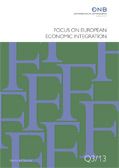Focus on European Economic Integration Q3/17
 OeNB
OeNB
- published:
- August 2017
 OeNB
OeNB
Call for entries: Olga Radzyner Award 2017 (PDF, 57 kB) en Aug 31, 2017, 12:00:00 AM
Call for applications: Visiting Research Program (PDF, 56 kB) en Aug 31, 2017, 12:00:00 AM
The New Silk Road, part I: a stocktaking and economic assessment (PDF, 776 kB) Barisitz, Radzyner. China’s New Silk Road (NSR) initiative was officially launched in 2013. It aims at enhancing overall connectivity between China and Europe by both building new and modernizing existing – overland as well as maritime – infrastructures. The NSR runs through a number of Eurasian emerging markets with important growth potential. The Chinese authorities have entrusted the Silk Road Fund, the Asian Infrastructure Investment Bank and other institutions with financially supporting NSR activities. Most drivers of the initiative are of an economic or a geopolitical nature. Given the generous financial means at Beijing’s disposal and Chinese firms’ accumulated expertise in infrastructure projects, many undertakings are currently well under way and promise to (eventually) bring about considerable changes in connectivity, commerce and economic dynamism. While most Chinese NSR investments go to large countries (e.g. Pakistan, Malaysia, Indonesia, Russia, Kazakhstan and Kenya), the strategically situated smaller countries (e.g. Djibouti, Sri Lanka, Kyrgyzstan, Laos, Serbia and Montenegro) typically benefit the most (in relation to the size of their economies). Progress has been made in strengthening the maritime infrastructural trade links with the EU (e.g. through the modernization of deep-water ports) while the upgrading of the currently rather weak trans-Eurasian railroad and highway links (e.g. via Kazakhstan and Russia) is clearly improving overland transportation’s yet modest competitive position. en New Silk Road, One Belt, One Road, connectivity, trade infrastructure, economic corridors, regional policy, China, Eurasia F15, F34, N75, R12, R42 Aug 31, 2017, 12:00:00 AM
Competitiveness of CESEE EU Member States: recent trends and prospects (PDF, 522 kB) Ritzberger-Grünwald, Schreiner, Wörz. This short study gives a comprehensive overview of the competitive strengths and weaknesses of the 11 Central, Eastern and Southeastern European (CESEE) EU Member States over the period from 2000 to 2014. It reviews traditional measures such as market share and price developments as well as indicators reflecting non-price competitiveness and the influence of integrated production networks. While the CESEE countries have shown impressive improvements in their competitiveness over the review period, some of these gains are clearly associated with processing high-quality inputs, the transfer of technological and managerial know-how within international production networks and the participation in potent marketing and distribution networks. However, the CESEE countries continue to lag behind Western Europe with respect to infrastructure, institutions and innovation. en competitiveness, international production networks, CESEE F14, L15, P52 Aug 31, 2017, 12:00:00 AM
Fintechs and their emergence in banking services in CESEE (PDF, 708 kB) Stern. Over the last years, the development of financial technology in the banking sector got a new twist with the emergence of numerous small start-ups called fintechs. Some of the new technologies will probably make specific areas of the banking business more efficient, while others may have the potential to disrupt the traditional banking sector. This paper presents the outcome of a stocktaking exercise and shows that most of the new financial technologies are still being used on a small scale. Given that the CESEE region is usually omitted in discussions of fintechs, this paper aims at closing this gap by giving an idea of which activities exist in this region with regard to financial technology. Focusing on three business areas – (1) financial services, (2) payments and (3) financing – this study finds that the level of adoption of new technologies varies across the CESEE countries. Also, a handful of countries seem to have a more active fintech scene in some areas (e.g. peer-to-peer lending) than many of their Western neighbors. en fintech, nonbank financial institutions, banks G21, G23 Aug 31, 2017, 12:00:00 AM
Comparing market power at home and abroad: evidence from Austrian banks and their subsidiaries in CESEE (PDF, 563 kB) Feldkircher, Sigmund. In this study, we examine markups of Austrian banks and their subsidiaries in Central, Eastern and Southeastern Europe (CESEE) on an unconsolidated level. Markups are evaluated by means of the Lerner index by simultaneously estimating a price and a cost function derived from oligopoly theory. For that purpose, we use a novel fixed effects seemingly unrelated regression approach and a unique supervisory dataset covering around 800 banks over the period from the first quarter of 2008 to the second quarter of 2016. We find evidence for positive markups for Austrian subsidiaries in CESEE. These markups are even higher than the markups of Austrian parent banks, which emphasizes the importance of the CESEE markets for the overall profitability of the Austrian banking sector. Looking at the determinants of markups for Austrian subsidiaries in CESEE, we find that higher Lerner indices are associated with better capitalization, higher loan loss provisions and, more generally, greater size – the latter effect is especially true for banks in more developed host countries. Also, there is a negative correlation between the Lerner indices of subsidiaries and parent banks. This implies that opportunity costs in the home country play a role in determining market power in the host country. en Lerner index, banking sector, market power, CESEE D40, G21, L10, C30 Aug 31, 2017, 12:00:00 AM
CESEE-related abstracts from other OeNB publications (PDF, 89 kB) en Aug 31, 2017, 12:00:00 AM